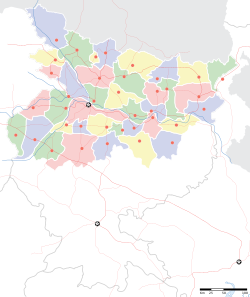Municipal Bodies
As per Census 2011, Bihar is the second least urbanised state in the country, with a rate of urbanisation of 11.3%, as compared to the national rate of 31.16%. [9] [10] The state has 139 StatutoryTowns and 60 Census Towns. [11]
For the administration of the urban areas, Bihar has 19 municipal corporations, 88 nagar parishads (city councils), and 154 nagar panchayats (town councils). [12] [13] [14] [15] [16] Bihar has one municipal act to establish and govern all municipalities in the state: Bihar Municipal Act, 2007. [17]
As per a 2017 report by the Comptroller and Auditor General of India, Urban Local Bodies (ULBs) in Bihar carry out 12 out of 18 functions, and the remaining 6 are carried out by Bihar state government departments. [18] The Fifth Bihar State Finance Commission report states that the ULB funds are ‘grossly inadequate for their assigned functions, they are unable to utilize even that’. [19]
The Bihar Municipal Act, 2007 creates the following categories of urban areas based on their population. All three types of urban areas must have at least 75% of their population engaged in non-agricultural work. [17]
| Types of Urban Areas according to the Bihar Municipal Act, 2007 |
| Type | Population Criteria | Type of Local Body |
| City | Larger urban area: 2 lakh or more | Municipal Corporation |
| Town | Medium urban area: 40 thousand or more but less than 2 lakh | Municipal Council |
| Small Town or Transitional Area | 12 thousand and more but less than 40 thousand | Nagar Panchayat |
Further, depending on the population size, the Act prescribes the minimum and maximum number of councillors/wards allowed within each type of local government.
| Minimum and Maximum number of Councillors/Wards Allowed according to the Bihar Municipal Act, 2007 |
| Population Range | Minimum | Incremental Number | Maximum |
| Municipal Corporations |
| Above 10 lakh | 67 | One additional Councillor for every 75,000 above 10 lakh | 75 |
| Above 5 lakh up to 10 lakh | 57 | One additional Councillor for every 50,000 above 5 lakh | 67 |
| Above 2 lakh up to 5 lakh | 45 | One additional Councillor for every 25,000 above 2 lakh | 57 |
| Municipal Council |
| Class 'A' Municipal Council | 42 | One additional Councillor for every 15,000 above 1,50,000 | 45 |
| Class 'B' Municipal Council | 37 | One additional Councillor for every 10,000 above 1 lakh | 42 |
| Class 'C' Municipal Council | 25 | One additional Councillor for every 5,000 above 40, 000 | 37 |
| Nagar Panchayat |
| Nagar Panchayat | 10 | One additional Member for every 2,000 above 12,000 | 25 |
The Act mentions the following key positions as well as committees for ULBs:
| Elected Officials | Administrative Officials | Committees |
|---|
| Councillor, Chief Councillor, Deputy Chief Councillor | Municipal Commissioner, Controller of Municipal Finances and Accounts, Municipal Internal Auditor, Chief Municipal Engineer, Municipal Architect and Town Planner, Chief Municipal Health Officer, Municipal Law Officer, Municipal Secretary, three Additional Municipal commissioners Such number of Joint Municipal Commissioners or Deputy Municipal Commissioners or Deputy Chief Municipal Engineers as the Empowered Standing Committee may, from time to time, determine, | Empowered Standing Committee, Joint Committee, Municipal Accounts Committee, Subject Committee, Ward Committee, Wards Committee |
Ward Committees
Bihar Municipal Act, 2007 mandates the establishment of Ward Committees through the Bihar Urban Local Body (Community Participation) Rules, 2013. [20] Section 31 of the Bihar Municipal Act, 2007 mandates the establishment of Ward Committees for each ward of a municipality. [17] The ward level elected councillor would be the chairperson of their respective Ward Committee. Up to 10 representatives from the civil society belonging to the ward would be nominated into the committee by the ULB.
Even though the creation of ward committees is mandated in municipalities, they have not been formed in Bihar. [21]





